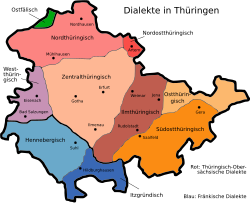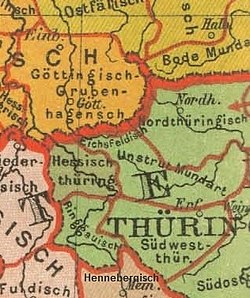West Thuringian
| West Thuringian | ||
|---|---|---|
|
Spoken in |
Thuringia | |
| Linguistic classification |
|
|
West Thuringian is a Thuringian-Upper Saxon dialect, which also has many features of East Franconian and individual features of Hessian , which is spoken north of the salt arch , in the Thuringian Forest north of the Rennsteig in the Wartburg district , in Eisenach and in parts of the north Hessian Werra-Meißner district . Ringgauisch is the historical name for this dialect.
Demarcation
The historical Ringgau dialect area essentially corresponds to the area of the historical Ringgau . To the west, the West Turkish borders on the West Central German Hessian dialect . Southwest of the salt arch is the Rhöner Platt , which is influenced by East Franconia and East Hesse . In the southeast, beyond the salt arch, the Main Franconian dialect Hennebergisch borders.
Historically, the transition area to the Rhöner Platt and the Henneberg dialect in the Bad Salzungen area was also viewed as a separate sub- dialect . The Salzunger Christian Ludwig Wucke was a dialect poet of the Salzunger dialect and the Rhöner Platt.
There is also information that describes West Thuringian as an old Franconian- Thuringian mixed dialect. Here the term Old Franconian refers to the fact that the corresponding parts of the language are older than the later development of Hessian and Franconian .
Characteristic
Examples of this are the pound / fund limit, the use of the / b / in question words ( boas 'was', boarümm 'why') and the preservation of three different gender forms of the numeral two ( two men, two women, two king ).
Already above the salt arch, in the area around the towns of Bad Salzungen and Bad Liebenstein, the transition to the soft East Franconian pronunciation of the consonants / t / and / p / begins to the south. To the north, on the other hand, the throaty pronunciation and “Saxon” as characteristics of Thuringian-Upper Saxon increase from here on.
literature
- Ludwig Hertel, Thüringer Sprachschatz, collection of dialect expressions from Thuringia with introduction, language map and language samples, page 26, Weimar 1895 - reprinted under a new title: Das Thüringer Mundartenbuch, Verlag Rockstuhl, Bad Langensalza 2010, ISBN 978-3-86777-260-0
- Heinz Rosenkranz, Der Thüringische Sprachraum, page 16, 2nd edition, VEB Max Niemeyer Verlag Halle (Saxony) 1964 - Reprint under the same title: Vogtländischer Heimatverlag Neupert Plauen, Plauen 2003, ISBN 3-935801-11-4
- Rudolph Flex: Contributions to research into the Eisenach dialect . 1893 u. 1898.
- Ludwig Hertel: Salzunger Dictionary. Jena 1893. - Reprint Verlag Rockstuhl, Bad Langensalze 2010, ISBN 978-3-86777-217-4
- Georg Brückner: The dialect of the city of Salzungen. In: German dialects. Vol. 2, Nuremberg 1855, pp. 280-284.
- Karl Regel: The Ruhla dialect . Weimar 1868.
- Karl Spangenberg: The dialect landscape between Rhön and Eichsfeld (= Middle German Studies. 25). Halle (Saale) 1962.
Web links
- West Thuringian on the pages of the Thuringian Dialect Research Unit of the Friedrich Schiller University Jena. However, there is no reference to the East Franconian language components, which can be found in other publications, including the Thuringian dictionary from 2006.
- Dialect and name spaces in Hessen
- Dialects in Hessen
- Oberhessische Presse: Three words for one number: "Zwie, zwou, zwa" , from December 18, 2009
Individual evidence
- ↑ "The Gaue after 900". Historical atlas of Hessen. In: Landesgeschichtliches Informationssystem Hessen (LAGIS).
- ↑ West Thuringian , Thuringian Dialect Research Unit at the University of Jena, accessed on November 7, 2017
- ^ Fritz rule: Thuringia - A geographical manual vol. 2, page 635; Verlag Fischer, Jena 1895
- ↑ Ludwig Hertel, Das Salzunger dictionary (The dialect book of the city of Bad Salzungen) - A small lexicon, Verlag Rockstuhl, 2016, ISBN 978-3867772174

